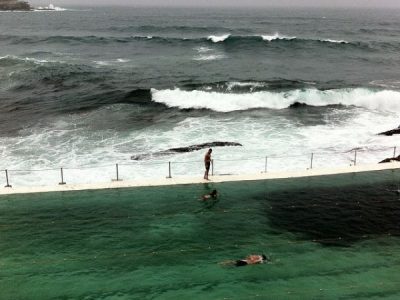Shore Platforms

Icebergs and likes of swell on a weirdly warm day #bondi365 #beachperspectives — at Bondi Icebergs Club. (photo source: Tom Fitzgerald)
Much has been written in the academic literature on the classification and origin of what are variously termed shore or rock platforms, wave-cut platforms, or even marine or shore benches. Readers will find much of this work reviewed in Colin Woodroffe’s majestic text on Coasts: form, process and evolution (Cambridge University Press, 2002) (see also T. Sunamura,1992, Geomorphology of Rocky Coasts, Wiley).
In some respects, I am as much a creature of platforms as of beaches! I learnt to swim in a pool carved into a platform at Bondi; as a kid I explored many platform pools for sea life; and later did my first geomorphology class exercise on platforms and cliffs at Coogee. Trevor Langford-Smith in his coastal course in 1959 placed an emphasis on platform evolution because at that time much of the local coastal literature focussed on questions of their type and origin. It was at this time I became aware of two rather special papers that fascinated me and continue to resonate whenever I think about or visit a shore platform.
The first is by that giant of coastal geomorphology, Douglas Johnson. He had published his great tome, Shore Processes and Shoreline Development, in 1919, a must read for any scholar of coastal morphology. But in 1931 he presented a paper at an International Geographical Congress on “Supposed two-metre eustatic bench of the Pacific shores” (see Woodroffe, p. 548 for full reference). This paper was the result of field visits to many sites in the Pacific region including New Zealand and eastern Australia. He addressed what was then a prevalent view that platforms with inner margins of less than one to more than two metres above high tide were “an indication of some recent change in the relative levels of land and sea” (p. 158). He concludes after a consideration of factors such as rock type and structure, exposure, and wave processes that this so-called two metre bench is “a normal feature of the present shore” (p. 163). He is not convinced of the need to invoke higher sea levels, either through uplift or eustatic fall, as the reason for the elevation of these benches. What is impressive is the way his keen eye looked at each site. For instance, he notes that “south of Melbourne the bench is developed now on one layer, now on another of nearly horizontal resistance lava sheets separated by weaker intervening layers”. To the north of Sydney, “the bench follows one resistant sedimentary layer downward along the coast until it becomes too low, then jumps to the next higher resistant formation” ( p.162). He also observes how bathing pools on this coast are cut into the rock bench and there is a dependence on waves for changing water in the pools, and how many are free of talus from the adjacent cliff suggesting that “waves sweep the benches with great vigor” (p. 161).
I can easily relate to these observations and conclusions. On field excursions in the Sydney area, I try to demonstrate the effect of different rock type and geologic structure on the elevation, position and geometry of a particular bench. Johnson was very careful in the way he handled possible ambiguities in the evidence. However, his conclusion reflected an awareness of the power of present-day process and the need to be extremely cautious in the interpretation of such features as the product of higher relative sea levels. I retain that caution in the way I look at shoreline phenomena of the past, present and what may be in the future. Having said that, we now have evidence from some locations of relict platforms around the Australian coast that are likely to be the product of past higher Last Interglacial or older sea levels.
The second paper was the initial publication in the Journal of Geomorphology, volume 1, number 1 , 1938, a journal edited by Douglas Johnson. The author of this paper was Chester K. Wentworth entitled “Marine bench-forming processes: water-layer weathering”. He opened my eyes to another aspect of platform development, the role of sea water collecting in pools on the surface with subsequent wetting and drying of the rock surface. He studied this process at various locations on rocks of different lithologies around the coast of Oahu, Hawaii. This paper introduced me to the concept of polygenesis of shore platforms. The interaction of weathering of the platform surface involving both physical and chemical processes, including the action of waves and the role of biological processes, has led to a more complex understanding of platform genesis expressed in recent years in the work of Sunamura and others. Wentworth also recognised that the present coastline where he worked “ would display both benches water levelled at the optimum level in relation to the present sea, and also benches inherited from an earlier stand, though still subject to the process” (p.30).
In reading these old papers I am grateful for three things: first I have reprints at my disposal, they are not papers easily found on the net! Second, that field observations can offer insights provided they are undertaken with a critical eye and a cautious approach to interpretation. And third, that Australia possesses a wonderful array of shore platforms in different environmental settings; as such they are an inheritance of processes past and present and in any coastal management plan there has to be careful consideration to the protection of their form and biology.
– words by Prof. Bruce Thom

